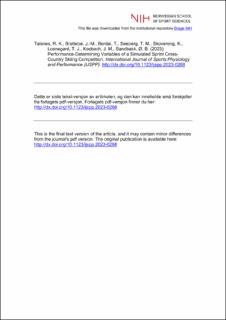| dc.contributor.author | Talsnes, Rune Kjøsen | |
| dc.contributor.author | Brattebø, Jan-Magnus | |
| dc.contributor.author | Berdal, Tore | |
| dc.contributor.author | Seeberg, Trine Margrethe | |
| dc.contributor.author | Skovereng, Knut | |
| dc.contributor.author | Losnegard, Thomas Johansen | |
| dc.contributor.author | Kocbach, Jan Martin | |
| dc.contributor.author | Sandbakk, Øyvind Bucher | |
| dc.date.accessioned | 2024-01-12T12:09:37Z | |
| dc.date.available | 2024-01-12T12:09:37Z | |
| dc.date.created | 2023-11-07T09:48:31Z | |
| dc.date.issued | 2023 | |
| dc.identifier.citation | International Journal of Sports Physiology and Performance (IJSPP). 2023. | en_US |
| dc.identifier.issn | 1555-0265 | |
| dc.identifier.uri | https://hdl.handle.net/11250/3111304 | |
| dc.description | I Brage finner du siste tekst-versjon av artikkelen, og den kan inneholde ubetydelige forskjeller fra forlagets pdf-versjon. Forlagets pdf-versjon finner du på humankinetics.com / In Brage you'll find the final text version of the article, and it may contain insignificant differences from the journal's pdf version. The definitive version is available at humankinetics.com | en_US |
| dc.description.abstract | Purpose: To investigate performance-determining variables of an on-snow sprint cross-country skiing competition and the evolvement in their relationship with performance as the competition progresses from the individual time trial (TT) to the final.
Methods: Sixteen national-level male junior skiers (mean [SD] age, 18.6 [0.8] y; peak oxygen uptake [VO2peak], 67.6 [5.5] mL·min−1·kg−1) performed a simulated sprint competition (1.3 km) in the skating style, comprising a TT followed by 3 finals (quarterfinals, semifinals, and final) completed by all skiers. In addition, submaximal and incremental roller-ski treadmill tests, on-snow maximal speed tests, and strength/power tests were performed.
Results: VO2peak and peak treadmill speed during incremental testing and relative heart rate, rating of perceived exertion, blood lactate concentrations, and gross efficiency during submaximal testing were all significantly correlated with performance in the TT and subsequent finals (mean [range] r values: .67 [.53–.86], all P < .05). Relative VO2peak and submaximal relative heart rate and blood lactate concentration were more strongly correlated with performance in the semifinals and final compared with the TT (r values: .74 [.60–.83] vs 0.55 [.51–.60], all P < .05). Maximal speed in uphill and flat terrain was significantly correlated with performance in the TT and subsequent finals (r values: .63 [.38–.70], all P < .05), while strength/power tests did not correlate significantly with sprint performance.
Conclusions: VO2peak and high-speed abilities were the most important determinants of sprint cross-country skiing performance, with an increased importance of VO2peak as the competition format progressed toward the final. | en_US |
| dc.language.iso | eng | en_US |
| dc.subject | maximal speed | en_US |
| dc.subject | 1-repetition maximal strength | en_US |
| dc.subject | peak oxygen uptake | en_US |
| dc.subject | submaximal testing | en_US |
| dc.subject | XC skiing | en_US |
| dc.title | Performance-Determining Variables of a Simulated Sprint Cross-Country Skiing Competition | en_US |
| dc.title.alternative | Performance-Determining Variables of a Simulated Sprint Cross-Country Skiing Competition | en_US |
| dc.type | Peer reviewed | en_US |
| dc.type | Journal article | en_US |
| dc.description.version | acceptedVersion | en_US |
| dc.source.pagenumber | 10 | en_US |
| dc.source.volume | 1 | en_US |
| dc.source.journal | International Journal of Sports Physiology and Performance (IJSPP) | en_US |
| dc.source.issue | 10 | en_US |
| dc.identifier.doi | 10.1123/ijspp.2023-0268 | |
| dc.identifier.cristin | 2193027 | |
| dc.description.localcode | Institutt for fysisk prestasjonsevne / Department of Physical Performance | en_US |
| cristin.ispublished | true | |
| cristin.fulltext | postprint | |
| cristin.qualitycode | 1 | |
